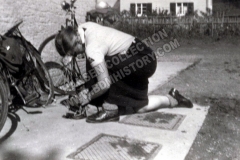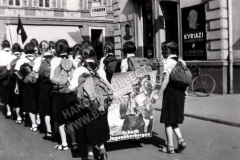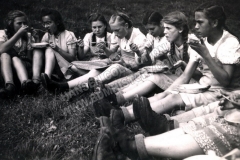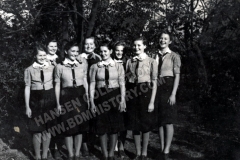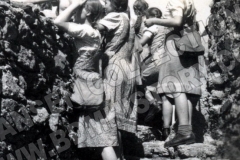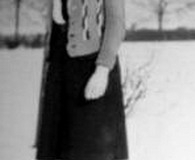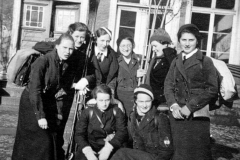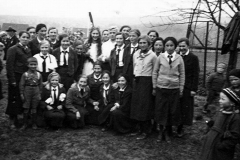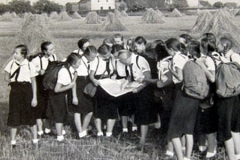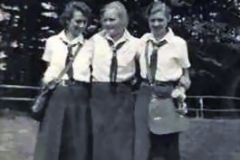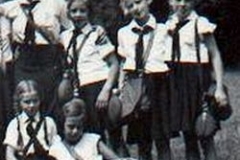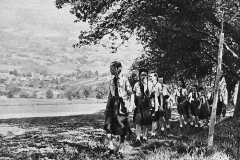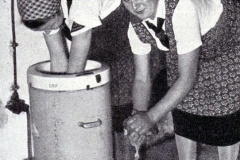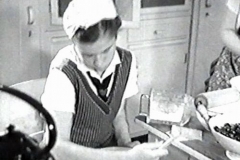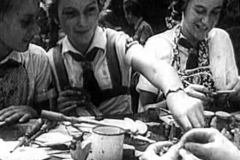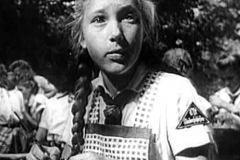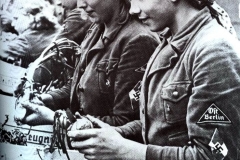The uniform accessories section is designed to cover items that are worn with the regular service uniform, such as the types of shoes and stockings, and items that would be worn with it in winter such as stockings, gloves, and scarves. If I have left anything out, or if someone is wondering whether they ever wore such-and-such, please email me and I’ll make sure to include that information in my next update.
→ Shoes and Stockings
→ Winter Accessories
→ Bags and Packs
→ Work Clothes
Shoes and Stockings
Shoes are the most varied item we see in photos of members of the League of German Girls. While there was a regulation shoe that could be purchased, uniform guidelines only said that shoes should be brown or black in color and of a sturdy lace-up type.
Therefore, girls’ shoes vary widely – flat shoes and shoes with a quarter inch heel were the most common, and they were either lace-up or the “Mary Jane” style that had one strap across the top. In Germany those are called Spangenschuhe.
For longer marches and hikes, a lace-up ankle boot was most commonly worn. These were either black or brown in color and of a simple design. Like the regular service shoe, they had leather soles and usually rubber heels. Ankle boots were always worn with a thick wool sock, which was supposed to be brown or grey in color. If it was cold, most of the time wool socks would be worn in the boots in addition to a regular thigh-high wool blend stocking.
In summer, girls also had the option of wearing sandals. The styles worn at the time had plain leather soles and a strap across the front of the foot, with another strap in the back that buckled around the ankle, as you can see in the photos below. Unlike nowadays, sandals back then were commonly worn with socks, not without.
BDM girls almost never wore back seam stockings that are so commonly associated with the 1930s and 1940s. Instead, girls wore white cotton ankle socks with their shoes in summer, and brown or grey cotton or wool thigh-high stockings during winter. Knee-high socks in white, brown, or grey were common with younger girls. “Nylons” did not exist in this time period – Nylon was invented in 1938 in the United States – so the only thin stockings in pre-war and wartime Germany were Perlon (a material similar to nylon), silk, or thin cotton blends, and it was uncommon for girls to wear those.
Below are a couple of photos showing different styles of shoes, stockings, and socks worn by members of the League of German Girls. When looking for the “right” kind of shoe to wear at events, it is often helpful to bring along photos of styles that were available back then, or at least have them in mind.
Winter Accessories
I don’t assume that a lot of you are planning to do living history events in the middle of winter – especially since they are few and far between – but I do want to touch on winter accessories that you can also use for cooler weather, like sweaters and hats the League of German Girls wore.
During fall and winter, BDM girls often wore knit wool jackets with their uniforms. Those are nice for sitting around the campfire in the evenings as well. Most of these sweaters were homemade by a mother or grandmother who knitted, and many of them resembled trachten sweaters in style. A very common design was the black Berchtesgaden sweater which had red and green trim and is often seen on BDM girls. But other civilian sweaters are very common as well and you should look at photos of girls wearing them to get a good idea of period styles that you can wear.
Official regulations prescribed that girls wore grey scarves and gloves during wintertime, but we see some variations in those as well. Many girls simply wore the civilian scarves they already had instead of buying something new in grey, and many girls’ gloves, scarves, and wool caps were either bought at the department store or homemade by a mother or grandmother.
Members of the Jungmaedel were authorized to wear a black knit cap called the Teufelskappe in winter. This was made from knit wool and had a white stripe down the center as well as ear flaps that could be folded up or down, depending on a girls’ preference. Older girls were not authorized to wear this, but instead had a black wool beret that could be worn. If it was very cold, girls sometimes wore knit wool caps.
Below are a couple of photos showing some of the winter accessories described in this section, which should get you started in your research. Make sure to check out the photo galleries on the main page for more images showing BDM girls in winter.
Bags and Packs
BDM girls generally did not carry purses or bags of any kind unless they went on longer trips, hikes, or travels. The most common bags and packs we see them with are either backpacks or bread bags, or both. Two styles of backpacks were most common – a large backpack with two outside pockets that was similar to most hiking rucksacks used during that time period, and a smaller pack called a Tornister that sometimes had a flap that was covered with fur. The bread bags were brown and had a shoulder strap for carrying that was either sewn on or would button onto the bread bag straps.
Below are photos of BDM girls with a couple of different styles of bags and packs.
Work Clothing
The League of German Girls did not have any specific work uniforms. Instead, they simply wore aprons over their regular BDM uniforms, and if there was need, kerchiefs to cover their hair. Both aprons and kerchiefs were ones that the girls already owned and could be any color or patterns that a girl liked (or could borrow from her mother). If you purchase or make aprons or kerchiefs, you will want to use only materials and patterns that were available then – printed linens or cotton are most common.
Below are photos of BDM girls wearing kerchiefs and aprons.



